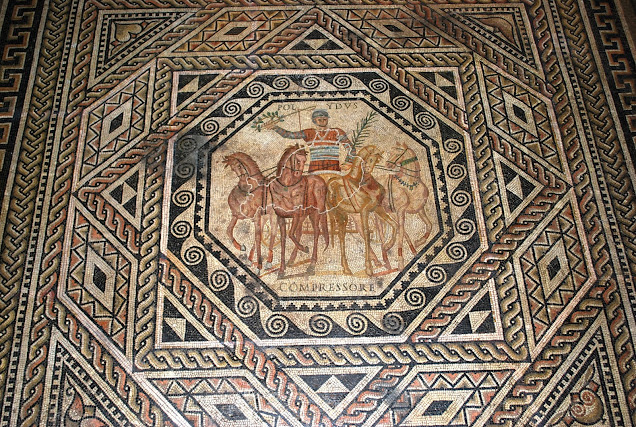More theaters in Judea: Antipatris
Last month, I learned that there are much more Roman theaters in Judea (Israel, Palestine and Syria) than the five I was aware of. Next to Herodium, Caesarea, Beth She'an (Scythopolis), Zippori (Diocaesarea) and Shuni, ten (sic!) more theaters have been excavated. Elussa (1), Antipatris (2), Dora (3), Gadara (4), Hippos (5), Samaria Sebaste (6), Jericho (7), Tiberias (8), Legio (9) and Mamas (10). I received some pictures from the internet, among the one of Antipatris.

Of the scanea frons almost nothing has remained. On the other hand, the space underneath the pulpitum (the hyposcaenium) has been well preserved. It is made of of three parallel walls perpendicular to the front of the stage that form two corridors joined by ten arches arranged in pairs. The semicircular orchestra, with a diameter of only 10 meters, was paved with carefully placed large stone slabs. The two aditus maximi are paved with similar large stone slabs which led it from the outside, and were originally barrel vaulted; from the theater they gave access to the nearby cardo.
The excavators date the theater to originally built between the 1st quarter of the 3rd and the second half of the 4nd century AD. Which is extraordinary late. The city of Antipatris was totally destroyed by an earthquake in 363 AD. It is possible that building had started during the short reign of Julian the Apostate, who admired classical culture and vigorously fought Christianity, which was then gaining control of the Roman Empire. Julian was killed in battle in the same year (363 AD) that the deadly earthquake destroyed not only the theater, but the entire city as well.
Alejandro Britos informed me that the theater seems to be covered by earth again, to be studied more thoroughly at a later date.

At this old picture, excavations were still going on. The small theater, unearthed at Aphek-Antipatris, is located at the southern part of the ancient tell on which Roman Antipatris was built. The theater faces east, with its stage building parallel to the southern part of the cardo which traverses the city north to south. Because of its small dimension, the excavators of Antipatris have called it an odeon. Since, in their opinion, it was never completed and because of its poor state of preservation, a full plan of the theater can not be constructed nor is it possible to ascertain what construction systems are used.
Of the scanea frons almost nothing has remained. On the other hand, the space underneath the pulpitum (the hyposcaenium) has been well preserved. It is made of of three parallel walls perpendicular to the front of the stage that form two corridors joined by ten arches arranged in pairs. The semicircular orchestra, with a diameter of only 10 meters, was paved with carefully placed large stone slabs. The two aditus maximi are paved with similar large stone slabs which led it from the outside, and were originally barrel vaulted; from the theater they gave access to the nearby cardo.
The excavators date the theater to originally built between the 1st quarter of the 3rd and the second half of the 4nd century AD. Which is extraordinary late. The city of Antipatris was totally destroyed by an earthquake in 363 AD. It is possible that building had started during the short reign of Julian the Apostate, who admired classical culture and vigorously fought Christianity, which was then gaining control of the Roman Empire. Julian was killed in battle in the same year (363 AD) that the deadly earthquake destroyed not only the theater, but the entire city as well.
Alejandro Britos informed me that the theater seems to be covered by earth again, to be studied more thoroughly at a later date.



Reacties
Een reactie posten